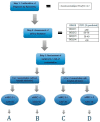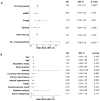Adherence to the GOLD Guidelines in Primary Care: Data from the Swiss COPD Cohort
- PMID: 37892775
- PMCID: PMC10607923
- DOI: 10.3390/jcm12206636
Adherence to the GOLD Guidelines in Primary Care: Data from the Swiss COPD Cohort
Abstract
(1) Introduction: Chronic obstructive pulmonary disease (COPD) and its associated morbidity and mortality are a global burden on both affected patients and healthcare systems. The Global Initiative for Chronic Obstructive Lung Disease (GOLD) issues guidelines with the aim of improving COPD management. Previous studies reported significant variability in adherence to these recommendations. The objective of this study was to evaluate Swiss primary practitioners' adherence to the GOLD guidelines for the pharmacological treatment of stable COPD. (2) Methods: We studied patients who were included in the Swiss COPD cohort study, an ongoing prospective study in a primary care setting, between 2015 and 2022. The key inclusion criteria are age ≥ 40 years, FEV1/FVC ratio < 70%, and a smoking history of at least 20 pack-years. Adherence to the GOLD guidelines was assessed per visit and over time. (3) Results: The data of 225 COPD patients (mean age 67 ± 9 years, 64% male) and their respective 1163 visits were analyzed. In 65% of visits (726/1121), treatment was prescribed according to the GOLD guidelines. Non-adherence was most common in GOLD groups A and B (64% and 33%) and mainly consisted of over-treatment (two long-acting bronchodilators in group A (98/195, 50%) and ICS in groups A (21/195, 11%) and B (198/808, 25%)). In group D, the prescriptions conformed with the guidelines in 99% of cases (109/108). Guideline adherence was associated with high symptom load (COPD Assessment Test) (OR 1.04, p = 0.002), high number of exacerbations (OR = 2.07, p < 0.001), asthma overlap (OR 3.36, p = 0.049), and diabetes mellitus (OR 2.82, p = 0.045). (4) Conclusion: These results confirm a conflict between the GOLD recommendations and primary practice, mainly concerning over-treatment in GOLD groups A and B. Patients with high symptom load, high exacerbation risk, asthma overlap, and diabetes mellitus are more likely to be treated in conformity with the guidelines. Further research is needed to uncover the reasons for the discrepancies and to design strategies for improvement.
Keywords: COPD; GOLD guidelines; adherence; bronchodilators; inhaled corticosteroids; primary care.
Conflict of interest statement
JDL is supported by grants from the Swiss National Science Foundation (SNF 160072 and 185592) as well as by the Swiss Personalised Health Network (SPHN 2018DR108). JDL has also received unrestricted grants from AstraZeneca AG Switzerland, Boehringer Ingelheim GmbH Switzerland, GSK AG Switzerland, Novartis AG Switzerland, and Sanofi AG Switzerland.
Figures






Similar articles
-
Impact of adherence to the GOLD guidelines on symptom prevalence, lung function decline and exacerbation rate in the Swiss COPD cohort.Swiss Med Wkly. 2012 Apr 5;142:w13567. doi: 10.4414/smw.2012.13567. eCollection 2012. Swiss Med Wkly. 2012. PMID: 22481636
-
Management of COPD in the UK primary-care setting: an analysis of real-life prescribing patterns.Int J Chron Obstruct Pulmon Dis. 2014 Aug 27;9:889-904. doi: 10.2147/COPD.S62750. eCollection 2014. Int J Chron Obstruct Pulmon Dis. 2014. PMID: 25210450 Free PMC article.
-
Adherence to current guidelines for chronic obstructive pulmonary disease (COPD) among patients treated with combination of long-acting bronchodilators or inhaled corticosteroids.Int J Chron Obstruct Pulmon Dis. 2012;7:201-9. doi: 10.2147/COPD.S25805. Epub 2012 Mar 15. Int J Chron Obstruct Pulmon Dis. 2012. PMID: 22500120 Free PMC article.
-
Contemporary issues in the care of patients with chronic obstructive pulmonary disease.J Manag Care Pharm. 2005 Jun;11(5 Suppl A):S2-13; quiz S14-6. doi: 10.18553/jmcp.2005.11.s5-a.1. J Manag Care Pharm. 2005. PMID: 15934804 Free PMC article. Review.
-
Management of chronic obstructive pulmonary disease in Swiss primary care: room for improvement.Qual Prim Care. 2012;20(5):365-73. Qual Prim Care. 2012. PMID: 23114004 Review.
Cited by
-
Pulmonary Embolism Management Audit and Machine Learning Analysis of Delayed Anticoagulation in a Swiss Teaching Hospital.J Clin Med. 2024 Oct 13;13(20):6103. doi: 10.3390/jcm13206103. J Clin Med. 2024. PMID: 39458053 Free PMC article.
-
The Management of Acute Exacerbations in COPD: A Retrospective Observational Study and Clinical Audit.J Clin Med. 2023 Dec 19;13(1):19. doi: 10.3390/jcm13010019. J Clin Med. 2023. PMID: 38202025 Free PMC article.
-
Treatment patterns for chronic obstructive pulmonary disease under the tiered medical system.Sci Rep. 2025 Jan 4;15(1):844. doi: 10.1038/s41598-024-85010-x. Sci Rep. 2025. PMID: 39755745 Free PMC article.
-
Proteinuria Assessment and Therapeutic Implementation in Chronic Kidney Disease Patients-A Clinical Audit on KDIGO ("Kidney Disease: Improving Global Outcomes") Guidelines.J Clin Med. 2024 Sep 9;13(17):5335. doi: 10.3390/jcm13175335. J Clin Med. 2024. PMID: 39274550 Free PMC article.
References
-
- Vestbo J., Hurd S.S., Agustí A.G., Jones P.W., Vogelmeier C., Anzueto A., Barnes P.J., Fabbri L.M., Martinez F.J., Nishimura M., et al. Global strategy for the diagnosis, management, and prevention of chronic obstructive pulmonary disease: GOLD executive summary. Am. J. Respir. Crit. Care Med. 2013;187:347–365. doi: 10.1164/rccm.201204-0596PP. - DOI - PubMed
-
- Celli B., MacNee W., Agusti A., Anzueto A., Berg B., Buist A., Calverley P., Chavannes N., Dillard T., Fahy B., et al. Standards for the diagnosis and treatment of patients with COPD: A summary of the ATS/ERS position paper. Eur. Respir. J. 2004;23:932–946. doi: 10.1183/09031936.04.00014304. - DOI - PubMed
-
- Russi E.W., Leuenberger P., Brändli O., Frey J.G., Grebski E., Gugger M., Paky A., Pons M., Karrer W., Kuhn M., et al. Management of chronic obstructive pulmonary disease: The Swiss guidelines. Official Guidelines of the Swiss Respiratory Society. Swiss Med. Wkly. 2002;132:67–78. - PubMed
-
- GBD 2015 Chronic Respiratory Disease Collaborators Global, regional, and national deaths, prevalence, disability-adjusted life years, and years lived with disability for chronic obstructive pulmonary disease and asthma, 1990–2015: A systematic analysis for the Global Burden of Disease Study 2015. Lancet Respir. Med. 2017;5:691–706. doi: 10.1016/S2213-2600(17)30293-X. - DOI - PMC - PubMed
Grants and funding
LinkOut - more resources
Full Text Sources

